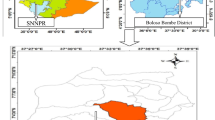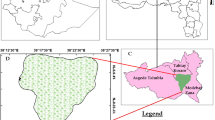Abstract
The Béni Bousera massif located in northern Morocco is characterized by an important peridotite outcrop that gave serpentine soil after alteration. This type of substrate is relatively rare and provides habitats harboring a well-differentiated flora of significant interest for biodiversity conservation. This study aimed to identify the woody vegetation communities of Béni Bousera and to assess their levels of diversity as well as their distribution according to soil type. Thus, 42 floristic surveys were carried out using the quantitative ecology method, and the plant communities were characterized by diversity indices (species richness and the Shannon and Piélou indices). The floristic surveys identified 67 woody species divided into six floristic groups (four in serpentine and two not in serpentine). They were structured according to an ecological gradient which combines environmental factors such as altitude and substrate type. Moreover, the plant communities found in serpentine had significantly higher levels of diversity and endemism than communities in the adjacent non-serpentine substrate. The results show that the Béni Bousera massif has a high ecological value and is of great interest for biodiversity conservation.






Similar content being viewed by others
References
Alexander EB (2004) Serpentine soil redness, differences among peridotite and serpentinite materials, Klamath Mountains, California. Int Geol Rev 46:754–764
Arrigoni PV, Ricceri C, Mazzanti A (1983) La vegetazione serpentincola del Monte Ferrato di Prato in Toscano. Centro di Scienze Naturali, Prato, pp 28
Ater M, Lefébvre C, Gruber W, Meerts P (2000) A phytogeochemical survey of the flora of ultramafic and adjacent normal soils in North Morocco. Plant Soil 218:127–135
Baker AJM, Proctor J, Reeves RD (1992) The vegetation of ultramafic (serpentine) soils. In: Proceedings of the First International Conference on Serpentine Ecology, University of California, Davis, 19–22 June 1991. Intercept, Andover, p 509
Bañares A, Blanca G, Güemes J, Moreno JC, Ortiz S (2003) Atlas y Libro Rojo de la Flora Vascular Amenazada de España. Dirección General de Conservación de la Naturaleza y Sociedad Española de Biología de la Conservación de Plantas, Madrid
Barbero M, Quezel P, Rivas-Martinez S (1981) Contribution à l’étude des groupements Forestiers et préforestiers du Maroc. Phytocoenologia 9(3):311–412. https://doi.org/10.1127/PHYTO/9/1981/311
Benabid A (1982) Étude phyto-écologique biogéographique et dynamique des associations et séries sylvatique du Rif occidental. Dissertation. Univ. Aix-Marseille-III, Aix-en-Provence
Benabid A (1983) Études biogéographique et dynamique des peuplements forestiers des peuplements forestiers du Rif. Ann Rech Forest Maroc 23:49–128
Benabid A (1984) Étude phytoécologique des peuplements forestières et préforestiers du Rif centro-occidental (Maroc). Institut Scientifique, Univ. Mohammed V, Rabat
Brady KU, Kruckeberg AR, Bradshaw HD (2005) Evolutionary ecology of plant adaptation to serpentine soils. Annu Rev Ecol Evol Syst 36:243–266
Brooks RR (1987) Serpentine and its vegetation: a multidisciplinary approach. Dioscorides, Portland
Brooks RR, Dunn CE, Edmondson J, Targuisti K, Asensi A, Reeves RD (1995) Phytosociological and biogeochemical observations on the serpentinite vegetation of the Betic Riffian ultramafic arc of Spain and Morocco. Ofioliti 20:67–79
Burroni A, Levi N, Marroni M, Pandolfi L (2003) Lithostratigraphy and structure of Lago Nero unit (Chenaillet massif, western Alps), comparison with internal Liguride units of northern Apennines. Ofioliti 28:1–11
Chiarucci A, Foggi B, Selvi F (1995) Garigue plant communities of ultramafic outcrops in Tuscany (central Italy). Webbia 49:179–192
Chiarucci A, Rocchini D, Leonzio C, De Dominicis V (2001) A test of vegetation environment relationship in serpentine soils of Tuscany, Italy. Ecol Res 16:627–639
Deil U (1984) Zur Vegetation im Zentralen Rif (Nord marokko). Diss Bot 74:1–324
Duvigneaud P (1966) Note sur la biogéochimie des Serpentines du sud-ouest de la France. Bulletin de la Société royale de Botanique Belgique 99:271–329
El Ghalabzouri A (2013) Interaction sol-végétation: exemple d’affleurements ultramafiques en région Méditerranéenne: Cas des affleurements de Béni bousera (W de Rif) au Maroc et du groupe de Voltri (Ligurie) en Italie. Dissertation. Univ. Abdelmalek Essaadi, Tétouan
El Ghalabzouri A, Ajbilou R, Mariotti MG, Ater M (2015) Vegetation of Béni Bousera (northern Morocco) ultramafic soils and adjacent non-ultramafic soils in relation to edaphic factors. Aust J Bot 63(4):353–366
Eldridge MM (2011) Serpentinites and other ultramafic rocks, why they are important for earth’s history and possibly for its future. In: Harrison SP, Rajakaruna N (eds) Serpentine: evolution and ecology in a model system. University of California Press, Berkeley, pp 3–28
Ellenberg D, Mueller-Dombois D (1974) Aims and methods of vegetation ecology. Wiley, New York
Fennane M, Ibn Tattou M (1998) Catalogue des plantes vasculaires rares, menacées ou endémiques du Marac. Bocconea Palermo 8:1–279
Fennane M, Ibn Tattou M (2005) Flore vasculaire du Maroc, inventaire et chorologie. Inst Sci Rabat Sér Bot 37(1):1–483
Fennane M, Ibn Tattou M, Mathez J, Ouyahya A, El Oualidi J (1999) Flore Pratique du Maroc. Inst Sci Rabat Sér Bot 36(1):1–560
Fennane M, Ibn Tattou M, Ouyahya A, El Oualidi J (2007) Flore Pratique du Maroc. Inst Sci Rabat Sér Bot 38(2):1–636
Fennane M, Ibn Tattou M, Ouyahya A, El Oualidi J (2014) Flore Pratique du Maroc. Inst Sci Rabat Sér Bot 38(3):1–800
Freitas H, Mooney H (1996) Effects of water stress and soil texture on the performance of two Bromus hordeaceus ecotypes from sandstone and serpentine soils. Acta Oecol 17:307–317
Frets E, Tommasi A, Garrido CJ, Mainprice D, Targuisti K, Amri I (2014) The Béni Bousera peridotite (Rif Belt, Morocco): an oblique-slip low-angle shear zone thinning the subcontinental mantle lithosphere. Petrology 55(2):283–313. https://doi.org/10.1093/petrology/egt067
Gaste H, Basly J, Botineau M, Verger J (2005) Bioaccumulation du chrome et du nickel par Cladonia portentosa, Hedwigia ciliata, Armeria arenaria et Festuca lemanii en milieu serpentinique (Lande du Cluzeau, Haute-Vienne). Ann Sci Limousin 16:23–33
Grime JP (1977) Evidence for the existence of three primary strategies in plants and its relevance to ecological and evolutionary theory. Am Nat 111(982):1169–1194
Guillot S, Hattori K (2013) Serpentinites: essential roles in geodynamics, arc volcanism, sustainable development, and the origin of life. Elements 9:95–98
Harrison SP, Inouye BD (2002) High β diversity in the flora of Californian serpentine “islands.” Biodivers Conserv 11:1869–1876
Harrison SP, Rajakaruna N (2011) Serpentine: the evolution and ecology of a model system. University of California Press, Berkeley
Harrison SP, Safford HD, Grace JB, Viers JH, Davies KF (2006) Regional and local species richness in an insular environment: serpentine plants in California. Ecol Monogr 76(1):41–56
Havrilchak NA, Schedlbauer JL (2017) Plant physiological changes along an encroachment gradient: an assessment of US Mid-Atlantic serpentine barrens. J Plant Ecol 11:853–865. https://doi.org/10.1093/jpe/rtx040
Ibn Tattou M, Fennane M (2008) Flore vasculaire du Maroc, inventaire et chorologie. Inst Sci Rabat Sér Botan 39(2):1–398
Kornprobst J (1969) Le massif ultrabasique des Beni bouchera (Rif Interne, Maroc): Etude des péridotites de haute température et de haute pression, et des pyroxénolites, à grenat ou sans grenat, qui leur sont associees. Contr Mineral Petrol 23:283
Kruckeberg AR (1985) California serpentines: flora, vegetation, geology, soils, and management problems. University of California Press, Berkeley
Kruckeberg AR (1986) An essay: the stimulus of unusual geologies for plant speciation. Syst Bot 11:455–463
Kruckeberg AR (2002) The influences of lithology on plant life. Geology and plant life: the effects of landforms and rock type on plants. University of Washington Press, Seattle, pp 1–362
Manthei CD (2012) Geochemical properties of the Béni Bousera (North Morocco) peridotites: a field and laboratory approach to understanding melt infiltration and extraction in an orogenic peridotite massif. Dissertation. Massachusetts Institute of Technology, Cambridge
McCune B, Mefford MJ (1999) PC-ORD, multivariate analysis of ecological data, version 4. MjM Software Design, Gleneden Beach
Médail F, Diadema K (2009) Glacial refugia influence plant diversity patterns in the Mediterranean basin. J Biogeogr 36:1333–1345
Moreno Saiz JC, Martínez García F, Gavilán R (2018) Plant conservation in Spain: strategies to halt the loss of plant diversity. Mediterr Bot 39(2):65–66
Ojeda F, Arroyo J, Marañón T (1995) Biodiversity components and conservation of Mediterranean heathlands insouthern Spain. Biol Conserv 72:61–72
Pérez-Latorre AV, Hidalgo-Triana N, Cabezudo B (2013a) Composition, ecology and conservation of the south-Iberian serpentine flora in the context of the Mediterranean basin. Anal Jardín Bot Madrid 70:62–71
Pérez-Latorre AV, Hidalgo-Triana N, Casimiro-Soriguer F, Cabezudo Artero B (2013b) Flora y vegetación serpentinícola ibérica, sierras de alpujata y de la robla (málaga, españa). Lagacalia 33:43–74
Piélou EC (1969) An introduction to mathematical ecology. Wiley-Interscience, New York
Pollard AJ, Reeves RD, Baker AJ (2014) Facultative hyperaccumulation of heavy metals and metalloids. Plant Sci 217:8–17
Proctor J (1999) Toxins, nutrient shortages and droughts: the serpentine challenge. Trends Ecol Evol 14:334–335
Proctor J, Woodell SRJ (1975) The ecology of serpentine soils. Adv Ecol Res 9:255–366
Proctor J, Lee YF, Langley AM, Munro WRC, Nelson Y (1988) Ecological studies on Gunning Silam, a small ultrabasic mountain in Sabah, Malaysia. I. Environment, forest structure and floristics. J Ecol 76:320–340
Quézel P, Barbero M, Benabed A, Loisel R, Rivas-Martinez S (1988) Contribution à l’étude des groupements pré-forestiers et des matorrals rifains. Ecol Mediterr 14:78–112
Rajakaruna N (2004) The edaphic factor in the origin of plant species. Int Geol Rev 46:471–478
Rajakaruna N (2018) Lessons on evolution from the study of edaphic specialization. Bot Rev 84:39–78. https://doi.org/10.1007/s12229-017-9193-2
Rajakaruna N, Boyd RS (2009) Advances in serpentine geoecology: a retrospective. Northeast Nat 16:1–7. https://doi.org/10.1656/045.016.0501
Rajakaruna N, Whitton J (2004) Trends in the evolution of edaphic specialists with an example of parallel evolution in the Lasthenia californica complex. In: Cronk QCB, Whitton J, Ree RH, Taylor IEP (eds) Plant adaptation: molecular genetics and ecology. NRC Research, Ottawa, pp 103–110
Reuber I, Michard A, Chalouan A, Juteau T, Jermoumi B (1982) Structure and emplacement of the Alpine-type peridotites from Béni Bousera, Rif, Morocco: a polyphaser tectonic interpretation. Tectonophysics 82:231–251
Saddiqi O, Reuber I, Michard A (1988) Sur la tectonique de dénudation du manteau infracontinental dans les Béni Bousera, Rif septentrional. Acad Sci 307(2):657–662
Saddiqi O, Feinberg H, El Azzab D, Michard D (1995) Paleomagnetisme des peridotites des Béni Bousera (Rif interne, Maroc): consequences pour l’evolution miocene de l’Arc de Gibraltar. Acad Sci 321(2):361–368
Selvi F (2007) Diversity, geographic variation and conservation of the serpentine flora of Tuscany. Biodivers Conserv 16:1423–1439
Shannon CE (1948) A mathematical theory of communication. Bell Syst Tech J 27:379–423. https://doi.org/10.1002/j.1538-7305.1948.tb01338.x
Sianta SA, Kay KM (2019) Adaptation and divergence in edaphic specialists and generalists: serpentine soil endemics in the California flora occur in barer serpentine habitats with lower soil calcium levels than serpentine tolerators. Am J Bot 106(5):690–703
Stevanovic V, Tan K, Iatrou G (2003) Distribution of endemic Balkan flora on serpentine. I. Obligate serpentine endemics. Plant Syst Evol 242:149–170
Targuisti K (1994) Petrologia y geoquimica de los macizos ultramaficos de Ojen (Andalucia) y de Béni Bousera (Rif Septentrional, Marruecos). Dissertation. University of Granada, Granada
Valdés B, Rejdali M, Achhal EK, Jury JL, Montserrat JM (2002) Catalogue des plantes vasculaires du Nord du Maroc, incluant des clés de d’identification. CSIC, Madrid
Verlaque R, Médail F, Quézel P, Babinot JF (1997) Endémisme végétal et paléogéographie dans le bassin méditerranéen. Geobios 30:159–166
Acknowledgements
The authors thank Prof. M. Kadiri (Faculty of Sciences of Tetouan) and Prof. M. Ibn Tattou (Scientific Institute of Rabat) for confirming the taxonomic status of certain taxa and Mr. A. El Ouahrani for his help in revising the English language. We would also like to thank the editors and two anonymous reviewers for their constructive comments that helped improve an earlier version of the manuscript.
Funding
No funding.
Author information
Authors and Affiliations
Corresponding author
Ethics declarations
Conflict of interest
The authors declare no conflicts or competing interest.
Availability of data and material
Not applicable.
Code availability
Not applicable.
Additional information
Communicated by Mohamed Ksibi.
Supplementary information
Below is the link to the electronic supplementary material.
Rights and permissions
Springer Nature or its licensor (e.g. a society or other partner) holds exclusive rights to this article under a publishing agreement with the author(s) or other rightsholder(s); author self-archiving of the accepted manuscript version of this article is solely governed by the terms of such publishing agreement and applicable law.
About this article
Cite this article
EL Ghalabzouri, A., Kassout, J., Khamlichi, A. et al. Diversity and structure of woody vegetation of the Béni Bousera massif, northern Morocco: conservation interest. Euro-Mediterr J Environ Integr 8, 863–873 (2023). https://doi.org/10.1007/s41207-023-00398-8
Received:
Accepted:
Published:
Issue Date:
DOI: https://doi.org/10.1007/s41207-023-00398-8




